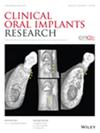The Effect of Placement Accuracy of Customized Titanium Mesh on Bone Regeneration: A Retrospective Study
Abstract
Objective
This study aimed to evaluate the accuracy of three-dimensional printed individualised titanium mesh (3D-PITM) placement in protected bone regeneration surgery for alveolar bone defects.
Material and Methods
This study included 15 patients with alveolar bone defects who underwent protected bone regeneration surgery using 3D-PITM as a scaffold. The 3D-PITM was removed 6–9 months post-bone regeneration surgery. Cone-beam computed tomography (CBCT) data allowed for digital comparison between the actual titanium mesh and the preoperative design, analyzing the overall deviation and deformation angle of the titanium mesh. Additionally, morphology modification of the augmented areas was analyzed, and the volume was calculated.
Results
The deviation of the titanium mesh immediately post-bone regeneration surgery from the preoperative design was 0.93 ± 0.22 mm. The maximum deformation angle of the titanium mesh immediately post-bone regeneration surgery was 21.49°, averaging 10.85° ± 6.70°. Correlation analysis indicated that a larger deformation angle post-bone regeneration surgery resulted in a greater deviation from the preoperative titanium mesh design. With one failure case excluded, the average actual bone augmentation achieved was 92.83% ± 26.12% of the design. Due to the small sample size, no significant correlation was found between the actual percentage of bone fill and the Root Mean Square (RMS) deviation and deformation angle of the titanium mesh.
Conclusion
Although 3D-PITM-protected bone regeneration provided effective bone augmentation, a noticeable deviation remained between the titanium mesh's actual position and preoperative design. However, due to the small sample size, there was a non-significant correlation between the actual percentage of bone fill volume and the RMS deviation and deformation angle of the titanium mesh.

 求助内容:
求助内容: 应助结果提醒方式:
应助结果提醒方式:


